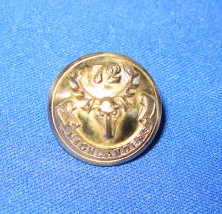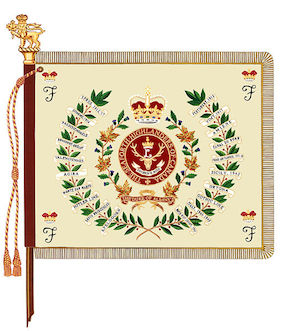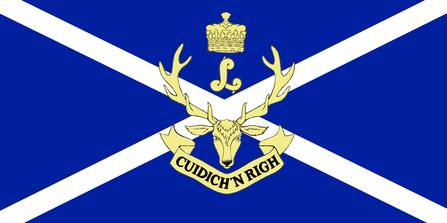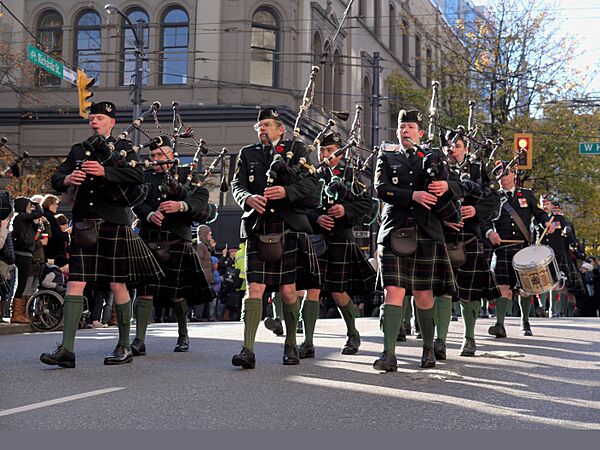Seaforth Highlanders of Canada facts for kids
Quick facts for kids The Seaforth Highlanders of Canada |
|
|---|---|

Regimental badge
|
|
| Active | 1910–present |
| Country | Canada |
| Branch | Canadian Army |
| Type | Light infantry |
| Part of | 39 Canadian Brigade Group |
| Garrison/HQ | Seaforth Armoury, Vancouver, British Columbia |
| Motto(s) | Cuidich'n righ (Scottish Gaelic for 'Aid the king') |
| March | "The Piobaireachd of Donald Dhu" |
| Engagements |
|
| Battle honours | See #Battle honours |
| Commanders | |
| Colonel-in-chief | Vacant |
| Insignia | |
| Tartan | Seaforth MacKenzie |
| Abbreviation | Seaforth of C |
The Seaforth Highlanders of Canada is an infantry regiment in the Canadian Army. They are based in Vancouver, British Columbia. This group is part of the Canadian military's Primary Reserve. This means its members are mostly part-time soldiers.
The regiment helps during wars and emergencies, like after earthquakes or floods. They also send volunteers to Canadian military missions around the world. The Seaforth Highlanders were formed in 1910. They fought overseas in both World War I and World War II. Since World War II, members have served in places like Korea, Egypt, Cyprus, Croatia, and Afghanistan.
Contents
How the Regiment Started
In 1909, people in Vancouver who were from Scotland wanted to create a new Scottish regiment. They held meetings to discuss this idea. On November 24, 1910, the government approved the formation of the new regiment. It was given the number 72. They would wear the same uniform and tartan (a special Scottish pattern) as the Seaforth Highlanders in Scotland.
On April 11, 1911, they received permission to use the name "Seaforth Highlanders of Canada." Their first parade was held on June 22, 1911, in downtown Vancouver.
The Seaforths first helped in an emergency in 1912. Coal miners near Nanaimo were on strike because of safety worries. There had been dangerous gas explosions. A group from the Seaforths was sent to keep the peace. No shots were fired, and peace was restored. The unit was called back in August 1914 to prepare for war.
Serving in World War I
When World War I began on August 4, 1914, the Seaforth Highlanders offered to serve overseas. Their request was first denied. Instead, many Seaforth members joined another group, the 16th Battalion Canadian Expeditionary Force. They made up almost half of that battalion. The regiment continued to recruit and send more soldiers to other battalions.
Finally, in July 1915, Major John Arthur Clark was put in charge of the 72nd Battalion (Seaforth Highlanders of Canada), CEF. This group was ordered to train for overseas service. The regiment traveled to the United Kingdom and then to France. By August 18, 1916, the Seaforths were in France. They were the only Canadian regiment in World War I to keep their traditional number, 72nd Battalion.
The Seaforths fought in some of the war's toughest battles. These included Ypres, the Somme, and Vimy Ridge. During the Battle of Vimy Ridge, some Seaforth soldiers showed incredible bravery. For example, Lieutenant D.O. Vicars and Private McWhinney captured a large part of the German line by themselves. The Germans even called the Seaforths "specially picked assault troops" because of their skill.
One of their most famous actions was capturing Crest Farm during the Battle of Passchendaele on October 30, 1917. The Commander-in-Chief said this was one of the greatest achievements by a single unit in British history.
World War I ended on November 11, 1918. The Seaforths stayed in France until May 1919 to help with cleanup. Before leaving, they received their new regimental colours (special flags). This ceremony was held on April 1, 1919.
Serving in World War II
In the spring of 1939, it looked like Canada would go to war again. This time, the Seaforth Highlanders were among the first to be sent overseas. On September 1, 1939, they were ordered to prepare for active service. In just one week, the regiment had enough soldiers for war. By Christmas 1939, they were sailing to Scotland.
After the Dunkirk evacuation, the Seaforths were one of the few fully equipped regiments in England. During the Battle of Britain, they helped defend against air attacks and protected the coast. In August 1942, a former Seaforth officer, Lieutenant Colonel Charles Merritt, won the Victoria Cross for his actions during the Dieppe Raid.
The Seaforths did not see combat until July 1943. They were part of Operation Husky, the invasion of Sicily. The landing was calm, but the Seaforths soon faced tough battles. They fought veteran German units for control of towns on hilltops.
On September 4, 1943, the Seaforths crossed into Italy. They chased the Germans north. The Germans were trying to gain time to build strong defenses further north. By October 25, the Seaforths had fought over 300 miles.
After a rest, the Seaforths returned to action. They reached the Gustav Line, where the Germans planned to make their first strong defense. From December 6 to 22, the Seaforths advanced only three miles to the town of Ortona. The fighting in Ortona was intense, with street-to-street combat. It was nicknamed "little Stalingrad".
During the fighting on Christmas night, 1943, the Seaforths' quartermaster arranged a Christmas dinner for the soldiers. They ate roast pork and mashed potatoes in a church. A soldier played the church organ while the battle raged nearby. The Germans left Ortona a few days later. Every year, the Seaforth Highlanders of Canada remember this battle with the Ortona Dinner.
From Ortona, the Seaforths continued fighting north. They broke through the Hitler Line, the Germans' second defensive line. This was one of their hardest battles in Italy. At one point, only eight soldiers remained on the line after a German counterattack.
The regiment kept fighting in Italy through the Gothic Line and across the Savio River. Here, Private E.A. "Smokey" Smith earned a Victoria Cross for his bravery. On March 13, 1945, the Seaforths sailed to Northwest Europe. They helped liberate The Netherlands.
The Seaforths entered The Netherlands on April 7. They crossed the IJssel River and chased the Germans west. On May 8, 1945, the Germans surrendered. The Seaforths were ordered to Amsterdam. They were the first Allied regiment to enter the city. The people of Amsterdam lined the streets to welcome their liberators. The war was over. On October 7, 1945, the Seaforth Highlanders returned home to Vancouver. About 100,000 people lined the streets to welcome them.
After World War II
The Seaforth Highlanders of Canada has not served overseas as a full regiment since World War II. However, its members continue to volunteer for missions around the world. Between 1950 and 1953, many Seaforths joined the full-time army to serve in the Korean War.
Since 1953, Seaforth members have volunteered for overseas and domestic operations. These volunteers, called "augmentees," fill empty spots in full-time army units. They return to their reserve regiments after their mission. Seaforths have volunteered for missions in Egypt, Cyprus, Croatia, Bosnia and Herzegovina, Kuwait, and Afghanistan.
In 1967, Prince Philip, Duke of Edinburgh, became the regiment's colonel-in-chief. He held this special position until he passed away in 2021.
In September 1993, Seaforth members were involved in fighting in the Medak Pocket in Croatia. They were part of a United Nations peacekeeping force. This was the first time Canadian troops had been in full combat since the Korean War.
Since January 2006, members of the Seaforth Highlanders have deployed to Afghanistan. They helped train the Afghan National Army and took part in combat operations.
The Seaforths Today
As a Primary Reserve unit, most Seaforth Highlanders are part-time soldiers. They train one night a week and one weekend a month. The rest of the time, they work civilian jobs or go to school. Many members also volunteer for full-time training or deployment opportunities.
Their weekly training nights involve learning skills needed by an infantry soldier. Monthly weekend training exercises take place at special training areas in British Columbia or Washington state. Here, soldiers practice the skills they learned during the week.
Members can volunteer to deploy full-time on missions around the world. In recent years, Seaforths have served in Croatia, Bosnia and Herzegovina, and Afghanistan.
100th Anniversary
In 2010, the Seaforth Highlanders of Canada celebrated their 100th anniversary. Three public events were held to mark this special occasion.
On May 29, the Seaforths hosted a military show and community party. This event included a ceremony honoring 20 Seaforth soldiers returning from Afghanistan.
On November 27, new regimental colours were presented to the regiment. The ceremony included performances by the Seaforth Highlanders of Canada Pipes and Drums. A Dutch pipe band, formed to honor the Seaforth's role in liberating The Netherlands, also performed.
On April 16, 2011, the regiment held a ceremony to retire their old colours. They then marched along Burrard Street in Vancouver, celebrating their "freedom of the city."
Seaforth Highlanders of Canada Museum & Archives
 |
|
| Location | Vancouver, British Columbia |
|---|---|
The Seaforth Highlanders of Canada Regimental Museum and Archives collects and shares items related to the regiment's history. The museum started in 1972 and is now an official Canadian Forces Museum. It has displays throughout the Seaforth Armoury. You can visit the museum by making an appointment through their website.
Regimental Traditions
Cap Badge
The regiment's cap badge shows a stag's head. Below it is a scroll with the Gaelic motto CUIDICH'N RIGH, which means "Aid the king." Above the stag's head is a special crown and symbol of Prince Leopold, Duke of Albany.
Battle Cry
The battle cry is Tuloch Ard, which means "The High Hill." This cry comes from the Clan Mackenzie in Scotland. It refers to a mountain near Kintail, which was their gathering place.
-
The pipes and drums of the regiment during a Remembrance Day parade in Vancouver, November 2014.
Notable Members
Many important people have been part of the Seaforth Highlanders. These include soldiers, business leaders, lawyers, and politicians.
Victoria Cross Recipients
The Victoria Cross is the highest award for bravery in the British and Commonwealth armed forces. Two members of the Seaforth Highlanders received this honor during World War II:
- Private (later Sergeant) Ernest Alvia ("Smokey") Smith for his actions in Italy in October 1944.
- Lieutenant Colonel Charles Cecil Ingersoll Merritt for his bravery at Dieppe, France, in August 1942. He later returned to command the Seaforths.
Cadet Units
Several Royal Canadian Army Cadets units in British Columbia are connected to the Seaforths. Cadets are young people aged 12 to 18. They are not soldiers, but they learn about citizenship and leadership with a military theme. They are not required to join the Canadian Forces.
| Corps | Website | Location | Meeting Times |
|---|---|---|---|
| 72nd RCACC | https://72armycadets.com/ | Vancouver | Tues. 6:30 - 9:00 PM |
| 2812 RCACC | https://www.2812rcacc.com/ | Surrey | Tues. 6:15 - 9:00 PM |
| 2893 RCACC | https://www.facebook.com/2893Seaforth/ | Port Coquitlam | |
| 2963 RCACC | https://www.facebook.com/2963seaforthhighlanders | Sechelt | Tues. 6:00 - 9:00 PM |
| 2277 RCACC | https://www.facebook.com/groups/2277rcacc/ | Langley | Mon. 6:00 - 9:00 PM |
| 1867 RCACC | https://www.facebook.com/1867rcacc/ | Delta | |
| 135 Sqn RCACS | http://www.135air.ca | Vancouver |
Cadet units linked to the Seaforth Highlanders get support from the regiment. They can also wear traditional parts of the regiment's uniform.
Images for kids
See also
- Canadian-Scottish regiment
- Trevor Greene
Order of precedence
| Preceded by Les Fusiliers de Sherbrooke |
The Seaforth Highlanders of Canada | Succeeded by The Canadian Scottish Regiment (Princess Mary's) |






